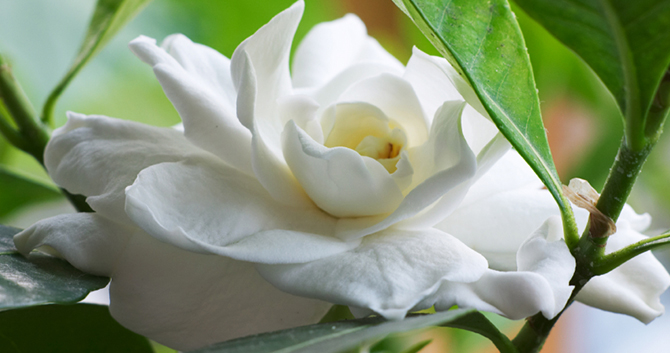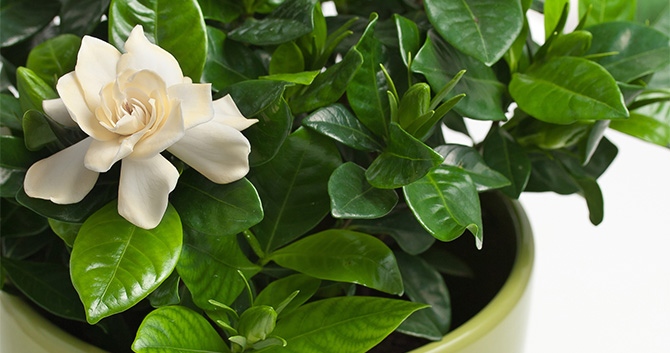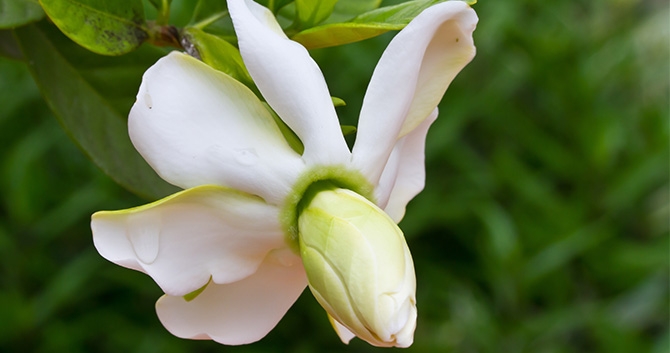Gardenias epitomize beauty and grace with intensely scented blooms in shades of pure alabaster and creamy yellow. Their sweet sultry fragrance is said to relieve stress, elevate the mood and cure insomnia; ideal for your bedside table where you can enjoy the hypnogenic scent while drifting into sleep.
Although seductively soothing, make no mistake - there’s nothing sleepy about gardenias! Their tight buds unfurl into pristine flowers spreading two to five inches across, framed by glossy dark green foliage.
History
Native to tropical and subtropical regions of Africa and southern Asia, gardenias (Gardenia jasminoides aka Gardenia augusta) thrive in high humidity, bright light, and mild temperatures. Cultivated in China for over 1,000 years, gardenias were first introduced to the United States in 1762 by Alexander Garden, after whom they are named.
 In the language of flowers, gardenia means secret love, purity and joy
In the language of flowers, gardenia means secret love, purity and joy
Ever since, gardenias have been synonymous with Southern charm, summer nights, and flirtatious rendezvous. In the language of flowers, gardenia means secret love, purity and joy, and they’ve become inextricably linked with romance. They’re tied on the wrists of prom girls, pinned to bridegrooms’ lapels, and fashioned into wedding centerpieces.
Selecting Gardenias
When selecting a gardenia, look for a plant with a few open flowers and abundant buds about to open. This will maximize the bloom time after you get home. Be sure the foliage is deep green and glossy without any signs of stress.
Care Tips
Not all of us are lucky enough to live in tropical regions, but that doesn’t have to limit our options. Fortunately humans are adept at controlling our home environment, giving us ample opportunity to enjoy these beautiful plants indoors. In ideal conditions, gardenias can bloom for months.
Gardenias have a prima donna reputation, withholding their performance unless their demands are met for light, moisture, and temperature. You may have to do some fine tuning and provide a little tender loving care for your gardenia to be happy in its surroundings. However, your efforts will be rewarded with beautiful flowers and heavenly fragrance.
Light
Gardenias thrive in bright light. Place your plant near a south-facing window where it will get plenty light, but just out of reach of direct sunlight. In winter months, when days are shorter, you may want to use a grow light to supplement the daylight and promote your plant’s health.
Humidity
Gardenias need plenty of humidity – dry air inhibits blooming and may cause buds to drop. For best results, either use a humidifier in the room or put your gardenia on a pebble tray (see Sidebar).
Temperature
Gardenias are sensitive to temperature, preferring a consistent 65 degrees Fahrenheit during the day and 60 degrees Fahrenheit at night. Above 70 degrees during the day and 65 degrees at night, they may drop buds that have already formed.
Avoid drafty locations near windows or doors, which can cause swings in humidity and temperature.
Water
Gardenias need consistent soil moisture. Two or three times a week, poke a finger into the soil to see if it feels dry about a half inch below the surface. If it is dry, take the plant to the sink, remove any pot saucer or decorative cover, and then pour water slowly over the soil surface until it begins to run out of the drainage holes in the pot. Let the plant rest for a half hour or so, and repeat the process, then return to its normal display location. You’ll soon learn your particular plant’s needs and know how often it will need to be watered.
Fertilizer
Gardenias thrive in acidic soil, with an ideal pH falling between 5 and 6. Whenever it is blooming or producing new leaves, fertilize your plant regularly with a product recommended for acid-loving plants such as Azaleas, Gardenias and Camellias, following product application instructions for indoor plants.
Repotting
 Gardenias are native to tropical and subtropical regions of Africa and southern Asia
Gardenias are native to tropical and subtropical regions of Africa and southern Asia
Gardenias bloom best when they are snug in their pots, so they should be repotted infrequently. You’ll know it’s time when plants dry out very quickly, as if there were more roots than soil in the pot. Choose a pot that is just an inch or two larger in diameter, and place a layer of good potting soil in the bottom. Gently remove the old pot, and without disturbing the roots, set the gardenia into its new container and fill in with soil around the edges.
After Blooming
Once flowers fade and the last bud has opened, we’re ready to start dreaming of our gardenia’s next performance. Reblooming a gardenia plant can be a challenge -- many opt to discard their plant after flowering and simply buy a new one loaded with buds and ready to roll. But plant-lovers are an adventurous lot, and getting your gardenia to bloom again is certainly worth a try!
In their natural, tropical outdoor environment, gardenias typically flower from summer into autumn—or whenever conditions are in the ideal temperature, moisture, and humidity ranges we outlined above. Plants take a break during the rest of the season. Your indoor gardenia will be revitalized by spending some time outdoors—and this helps to trigger a new round of flowers. When evening temperatures warm to consistently above 55°F, it’s time to act.
You’ll want to gradually transition your plant to prevent any shock. Start with a few hours in bright shade, and over the course of a week or so, give it a bit of morning sun, then half a day, and finally up to all day sun. Once acclimated, gardenias prefer locations with six or more hours of morning sun or bright dappled sunlight. Keep it shaded from direct afternoon sun in the hottest part of the summer.
 Gardenias are actually members of the coffee family!
Gardenias are actually members of the coffee family!
Keep an eye on evening temperatures and plan to bring your gardenia back indoors in late summer or early fall once temperatures dip near 55°F. This gradual cooling helps trigger the plant to rebloom—but it must not get too cold, either!
Inspect your plant carefully for any signs of pests or disease and treat them before bringing indoors. Natural rainfall, wind and beneficial insects tend to keep problems in check outdoors, but they can quickly overwhelm your plant once it is back indoors.
Return your plant to that ideal indoor location, with bright light, good humidity and temperatures in a consistent 65-70 degree range. Flowers should follow in a month or so.
Troubleshooting
Gardenias are sensitive to environmental changes, and will let you know when they are not getting what they need. Generally it is just a matter of fine-tuning until you hit the right balance. And we have some helpful insights and suggestions to help you through that process.
“Bud drop” occurs when the flowers stop growing right before blooming. You may also see some leaf drop or leaf yellowing. A sudden change in environment is usually responsible – simply adjust the conditions or move the plant to a more suitable location.
Re-evaluate the light levels; too little sunlight may be the cause
Is the room dry? Avoid low humidity by using a humidifier or a pebble tray and mist daily.
Check the room temperature to make sure it is staying in range—a thermometer that registers the high and low temps as well as the current one is a helpful monitor.
Has the plant recently dried to the point of wilting, or soil been soggy for an extended time? If so, adjust your watering frequency.
Occasionally insect pests can affect your gardenia, usually when it is stressed. They are safely and easily controlled with an insecticidal soap. For best results, use a commercial preparation rather than a home-made recipe.
Yellowing leaves, a ‘bleached’ look, or fine webbing can be a sign of spider mites; a very tiny insect pest that can be difficult to see without a magnifying.
Small, white cottony deposits suggest mealy bugs
A sticky residue, black 'sooty' film or brown raised bumps on the leaves are an indication of scale














